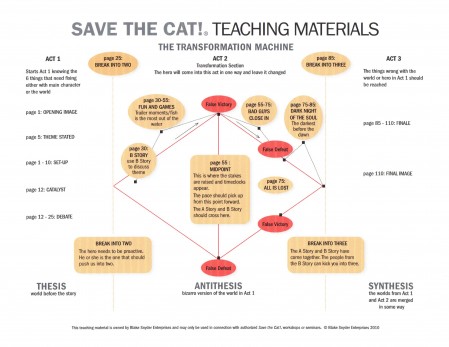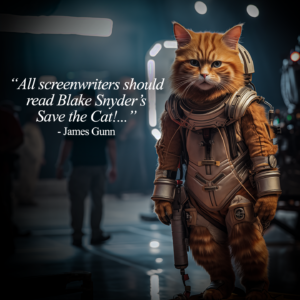
In 2008, just before he began writing his third book, Blake Snyder wrote a blog for the wonderful folks at Script Frenzy, entitled MIDPOINT – THE KEY TO CRACKING ANY STORY. In celebration of the current Script Frenzy — taking place soon, we’re proud to republish Blake’s words:
In both my Save the Cat! books and also the Save the Cat! Story Structure software, I have stressed the vital importance of figuring out what the midpoint of a screenplay is. I like to say that if you can crack the midpoint, you can crack the story. And it may not be until you do that you truly know what your story is really about!
To me, the day I discovered there is a secret to what happens at the midpoint in EVERY story, I was rocketed into a whole new dimension in my abilities as a writer.
There are two things that have to happen at the midpoint, both vital to making your story work:
* “the stakes are raised,” and
* a “time clock” appears
When we meet the hero in Act One, and he decides to go on an adventure in the Break into Act Two, it isn’t until midway through the movie that these two key elements cause him to truly decide if continuing on is for him. Thus the midpoint becomes a vital “weigh station” for the hero of every story, primarily because of these two simple devices.
Here are three classic examples of a midpoint when both the “stakes are raised” and a “time clock” appears:
* In Titanic, Kate Winslet is a pampered Victorian debutante when she begins her journey, engaged to the wrong guy, tied to her fearful mother, suicidal, and then she meets him… Leonardo DiCaprio. For the first half of Act Two, she and Leo fall in love, and at midpoint, two key things happen: They make love (ending her relationship with Billy Zane) and, most importantly, the Titanic hits an iceberg. These two “stakes-are-raised” beats force Kate to decide, and mostly force her to change. Is she really in love with Leo? Is she really committed to leaving her mother’s world behind? Kate must figure it out—and fast!—because there is cold water rushing in, sinking the ship. Meanwhile, the captain, having learned his ship has hit a big ice cube, turns and asks “How much time do we have?” This “time clock” serves the function of accelerating the pace of the story to the end.
* These beats don’t just happen in dramas. In Bruce Almighty, the midpoint occurs when Jim Carrey, as weatherman Bruce Nolan, realizes that the godly powers he got from Morgan Freeman have a price: he has to answer prayers too, not just get his own wishes granted! The “stakes are raised” in his adventure, and lo! a “time clock” appears as the number of prayers he must answer begin to accelerate.
* And in Alien, the midpoint is the moment when, having previously thought John Hurt had sloughed off the monster who grabbed onto his face while he was leaning over a hatching alien egg, we see John sitting at dinner with the rest of the crew of the Nostromo when suddenly the monster pops out of his chest, takes a look around, and scampers away into the darkness. Talk about “stakes are raised”! The annoying inconveniences of picking up an alien hitchhiker just got a lot more serious, and guess what else? The “time clock” of having to track that thing down and kill it before it morphs into a bigger problem starts ticking away like mad.
Cracking your midpoint is the key to figuring out not only where your story goes, but what it means. By forcing these “stakes-are-raised” moments on your protagonists, and laying in the accompanying “time clocks” that put pressure on them to decide what to do, you may make their lives more difficult, but you also force them to address the changes that will truly make them worthy of the term “hero.”
BJ Markel
13 Comments
Leave a Reply Cancel reply
You must be logged in to post a comment.









Great discovery and such a good thing to think about. Thanks for finding this! Miss you, Blake.
Very good, don’t forget there’s also a public declaration of the hero (and as a result the bad guy finds the hero), as well as the A and B stories crossing. One thing that I find annoying in many movies is they don’t put a time clock in their midpoints. It would make an otherwise good movie excellent if writers and directors knew the importance of it.
One of my favorite Blake inspired, “Ah-ha!” moments!
To AlRod, CruCat, and BradR,
I’m on page 41 with “Professor Fishborne”. Because of you, I will stop writing, go to page 55, and make sure I got the mid point nailed.
Then I will go back and write to the midpoint. My writing will be going somewhere instead of departing a previous sequence. It’s what I have just now learned.
At page 55, it really is a new movie, in a different world at an amped up pace.
Thanks,
Captain
I agree among many ‘Ah-ha’ moments Blake gave me, this one is crucial. The three things Blake said you had to know before (after nail the logline) you begin writing are Opening Image, Mid-Point and Final Image… It took a while after his Beat classes for this to truely sink in. Thanks again for the “ticking clock” reminder at this perfect time.
I believe Blake is still guiding us…
Miss you Blake.
Namaste Speedo
Captain, “Professor Fishborne” immediately makes me picture Laurence Fishburne’s character in Higher Learning.
I think you’re getting round to the story cycle (right now you’re at some form of diamond shape but at least you loop back to the beginning). It’s all really well explained at http://www.clickok.co.uk/index4.html ; the best story structure site by far.
FYI: The link above is Kal Bashir’s website. Kal likes to stop by from time to time, usually posting under various aliases, to let us know that he prefers Chris Vogler over any other story guru.
yup, all good stuff here. the little things that slip your mind…
OK I nailed the mid point, and started writing.
Guess what?
My Characters sense what’s coming and are changing their attitudes and actions on page 45 to forshadow an incredible event to happen at midpoint.
This is fantastic advice, and super timely as I’m in revision right now and happen to be (ta da!) right at the midpoint. I’m primed to take Blake’s advice and rock my MS!
Thank you for reposting this!
Hello all,
I’m hoping you can help me.
I’ve been watching “Elf”, and am trying to figure out where the midpoint is in the film. It’s so full of “Fun and Games”, and places where the stakes are raised, it’s difficult to pinpoint where it is.
As for the time clock — the only place I see that appearing is during act 3, when Buddy races to help Santa, and his father and stepbrother go looking for him. (Or is it when Buddy runs away…?)
Would love to hear where you think the midpoint is in “Elf”.
Thanks in advance.
Isnt there a point where the initial children’s story ideas are all terrible and they have a deadline to make which leads them to call Miles Finch and causes the all is lost moment? That is a ticking clock which pushes the script along. But good question as I am not sure either. Trying to remember the whole movie.